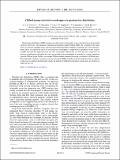| dc.contributor.author | Bunandar, Darius | |
| dc.contributor.author | Englund, Dirk R. | |
| dc.date.accessioned | 2021-01-29T15:22:34Z | |
| dc.date.available | 2021-01-29T15:22:34Z | |
| dc.date.issued | 2020-06 | |
| dc.date.submitted | 2020-03 | |
| dc.identifier.issn | 2469-9934 | |
| dc.identifier.issn | 2469-9926 | |
| dc.identifier.uri | https://hdl.handle.net/1721.1/129596 | |
| dc.description.abstract | Quantum key distribution (QKD) promises provably secure cryptography, even to attacks from an all-powerful adversary. However, with quantum computing development lagging behind QKD, the assumption that there exists an adversary equipped with a universal fault-tolerant quantum computer is unrealistic for at least the near-future. Here, we explore the effect of restricting the eavesdropper's computational capabilities on the security of QKD and find that improved secret key rates are possible. Specifically, we show that for a large class of discrete variable protocols higher key rates are possible if the eavesdropper is restricted to a unitary operation from the Clifford group. Further, we consider Clifford-random channels consisting of mixtures of Clifford gates. We numerically calculate a secret-key-rate lower bound for BB84 with this restriction and show that, in contrast to the case of a single restricted unitary attack, the mixture of Clifford-based unitary attacks does not result in an improved key rate. | en_US |
| dc.language.iso | en | |
| dc.publisher | American Physical Society (APS) | en_US |
| dc.relation.isversionof | 10.1103/PhysRevA.101.062318 | en_US |
| dc.rights | Article is made available in accordance with the publisher's policy and may be subject to US copyright law. Please refer to the publisher's site for terms of use. | en_US |
| dc.source | APS | en_US |
| dc.title | Clifford-group-restricted eavesdroppers in quantum key distribution | en_US |
| dc.type | Article | en_US |
| dc.identifier.citation | Govia, L. C. G. et al. “Clifford-group-restricted eavesdroppers in quantum key distribution.” Physical Review A, 101, 6 (June 2020): 062318 © 2020 The Author(s) | en_US |
| dc.contributor.department | Massachusetts Institute of Technology. Department of Electrical Engineering and Computer Science | en_US |
| dc.relation.journal | Physical Review A | en_US |
| dc.eprint.version | Final published version | en_US |
| dc.type.uri | http://purl.org/eprint/type/JournalArticle | en_US |
| eprint.status | http://purl.org/eprint/status/PeerReviewed | en_US |
| dc.date.updated | 2020-12-14T19:06:25Z | |
| dspace.orderedauthors | Govia, LCG; Bunandar, D; Lin, J; Englund, D; Lütkenhaus, N; Krovi, H | en_US |
| dspace.date.submission | 2020-12-14T19:06:30Z | |
| mit.journal.volume | 101 | en_US |
| mit.journal.issue | 6 | en_US |
| mit.license | PUBLISHER_POLICY | |
| mit.metadata.status | Complete | |
